Software outsourcing services are a popular business solution that many organizations rely on for their technical requirements. As these outsourcing services continue to thrive because of their ability to deliver significant value to stakeholders, they remain the prime choice for businesses looking to scale flexibly.
Aloa is a software development outsourcing company with a global partner network. Our team has vetted 10,000+ skilled professionals in the industry to front the top talent pool for clients looking to outsource development. With services ranging from app development, web development, mobile development, and custom software development, our team has a proven track record of ensuring our clients meet their software development needs and goals on time, on budget, and in high quality.
Applying our expertise in the industry, we've put together this comprehensive guide on software outsourcing services. We'll go through the different software outsourcing types and models, how to start leveraging such services, and the common scenarios in which businesses benefit most from such services.
After reading, you'll have a complete idea of how to effectively and efficiently outsource development, resulting in improved scalability and business continuity.
Let's get started!
What are Software Outsourcing Services?
Software outsourcing services are a business practice in which companies delegate software development tasks to external organizations or third-party vendors. This strategy enables businesses to leverage the expertise, resources, and technology of specialized software development teams globally without needing to maintain an in-house team.
With software outsourcing, businesses can grow their digital presence and address technological gaps while cutting down project costs. The flexibility outsourcing strategies provide also makes them ideal for handling abrupt demands for scaling development up or down.
Startups and large-scale businesses realize great potential by considering outsourcing for their development needs. This is because it allows them to access a global pool of talent with a rich skill set in programming, coding, and other software development professions. Taking advantage of this opens up the chance to stay relevant in the digital world by ensuring projects apply the latest technological software solutions.
4 Types of Software Outsourcing Services
Software outsourcing services come in different options and cater to varying business needs. These outsourcing software development services offer unique benefits, so selecting them based on project requirements like budget constraints and business goals is best.
Here are the main types of software outsourcing services to explore for your business development needs:
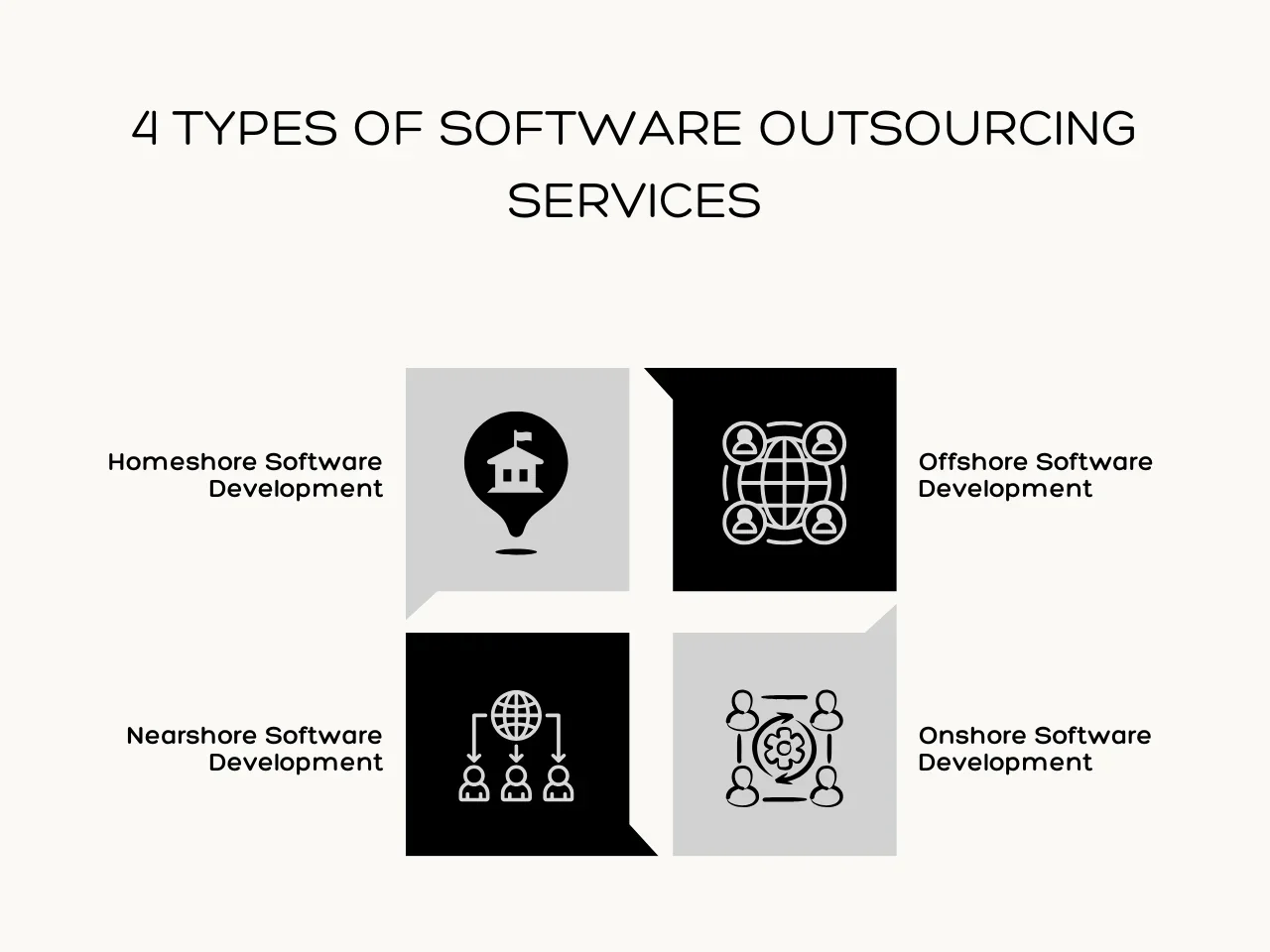
1. Homeshore Software Development
Homeshore software development involves delegating the project to a software development team within the same city or region you're in. The proximity allows client companies and teams to invite developers for face-to-face meetings.
The core benefit of homeshore development outsourcing is the ease of collaboration and communication. Since the outsourced development team and the client company are within the same city or country, there is little risk of communication barriers. It's also simpler to manage the project and ensure high levels of quality control with on-site visits.
As a drawback, homeshore outsourcing services often come at a high price point compared to nearshore and offshore options. This is because you work with outsourced developers who share the same environment and cost structure as your own company.
2. Nearshore Software Development
Nearshore outsourcing development services involve working with an outsourcing company located in a nearby country. It is a good option if you prioritize skill set expertise, cost-effectiveness, and minimal to no timezone difference.
Nearshoring to geographical locations like Latin America for companies in the United States and Eastern Europe for companies in Western Europe leverages several advantages. The short geographical distance makes arranging face-to-face meetings easier and less expensive, fostering better collaboration and relationship building.
Many nearshore locations boast a highly skilled and educated workforce, providing access to top-tier talent that can meet the technical and professional standards required for complex projects. While more inexpensive than offshore outsourcing, nearshoring often offers a more affordable alternative to homeshore outsourcing, allowing companies to save on labor and operational costs without compromising quality.
3. Offshore Software Development
Offshore outsourcing developmentwork is commissioned to distant countries. It can entail considerable timezone distinctions and language barriers. However, this type of outsourcing provides access to more skilled developers that might not be available for the first two options.
Apart from having a wider pool of professional developers to choose from, offshoring also provides the potential for lower cost of services. Typically, offshore outsourcing refers to working with professionals in countries like Southeast Asia, India, and Africa, places with lower costs of living. Since these locations have a lower cost of living, the developers can provide cost-effective prices compared to homeshore and nearshore outsourcing.
So long as your company can establish strong communication plans effectively and share a similar working culture as your chosen developers, offshore outsourcing can be a highly effective solution for developing software at the lowest cost possible without compromising on quality results.
4. Onshore Software Development
Onshore software outsourcing services involve delegating software development tasks to a team in the same country but outside the client company's immediate city or region. Their main benefit is providing access to a diverse range of skilled professionals across the entire country, allowing businesses to find the right expertise for their specific needs.
This approach allows businesses to benefit from local expertise while maintaining certain conveniences and advantages of domestic outsourcing.
Working with a development team within the same country ensures minimal language barriers and cultural differences, leading to smoother communication and collaboration. Legal and regulatory compliance is simplified as the client and the outsourcing provider operate under the same national laws and regulations.
When deciding on which software outsourcing service to use, it's essential to carefully consider the balance between specific business needs and goals and financial constraints. In doing so, businesses can make informed decisions that greatly benefit their overall strategy and project outcomes.
3 Types of Software Outsourcing Models
In addition to the different types of outsourcing software development services, three outsourcing engagement model options exist. These outsourcing development models focus on the various aspects of project management, engagement, and collaboration. By considering each type of outsourcing model, businesses can select an approach that best fits their organizational needs and objectives.
Let's break down the three types of outsourcing development models to consider:
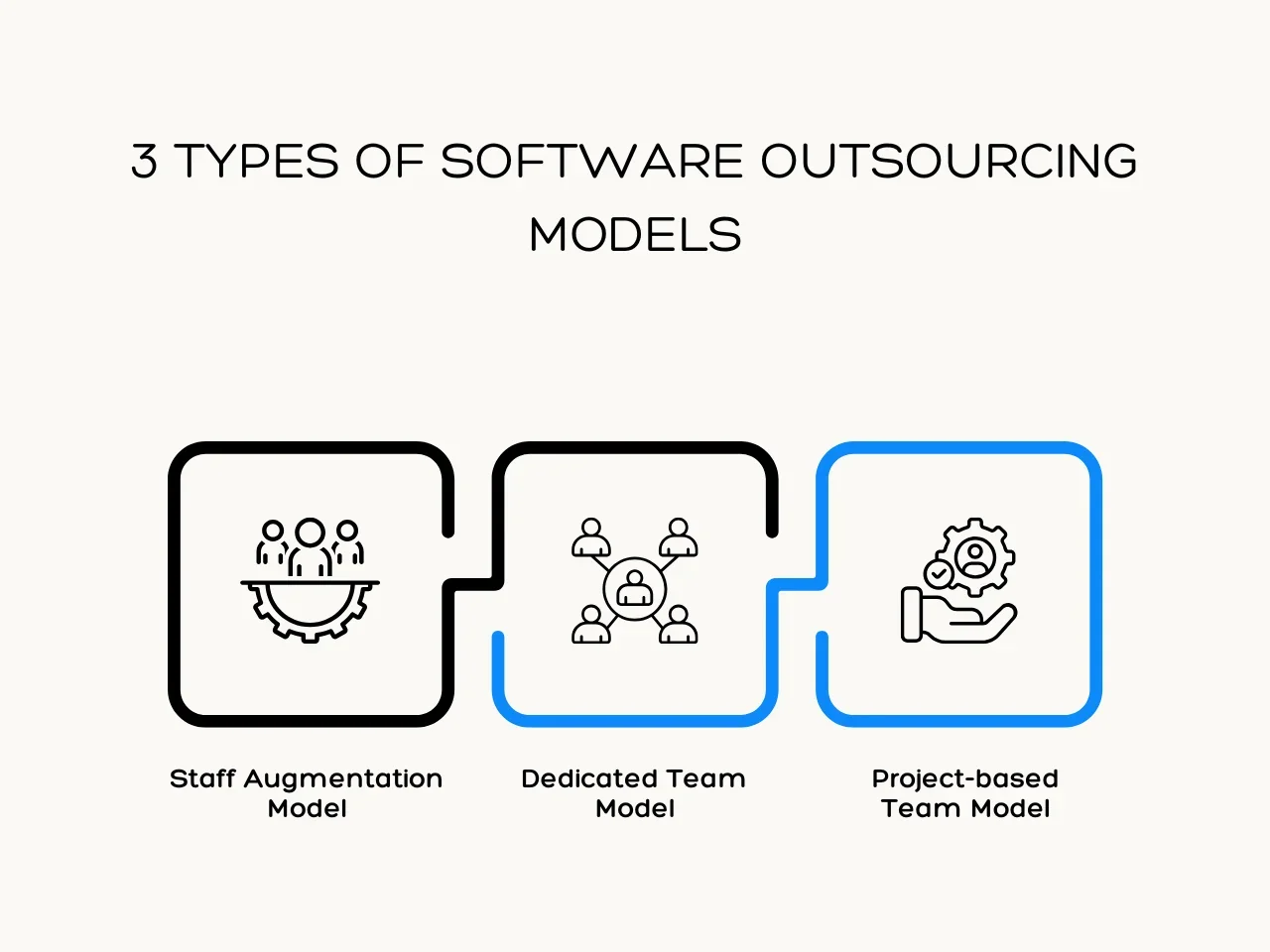
1. Staff Augmentation Model
Staff Augmentation involves partnering with an outsourcing company to put together a software development team. This team will handle the day-to-day operations and bring the project to completion. With staff augmentation, clients also collaborate closely with their chosen partners on who to work with, how the team should be, and how to distribute responsibilities to each developer on the team.
2. Dedicated Team Model
The dedicated team model is when the outsourcing services handle every aspect of the project. Additionally, teams are retained for future projects. With a dedicated team model, businesses benefit from long-term collaborations. Over time, the team becomes deeply familiar with the client's business goals, processes, and expectations, leading to more efficient and effective project execution.
3. Project-based Team Model
A project-based team model works with the client on a per-project basis. Outsourcing services handle most of the decision-making aspects of the project, and the client is updated through progress reports. A project-based model suits businesses that want to delegate the entire project management process to the outsourced team. It's also the best choice for those with a fixed budget and timeline for one specific project.
How to Start Leveraging Software Outsourcing Services
Leveraging software outsourcing services requires that client companies do their research and vetting before finalizing a partner or team to work with. Evaluating each potential partner ensures you bring on the best team possible that can provide you with smooth project implementation and delivery.
Here are the essential steps to follow when choosing a software outsourcing service provider to work with:
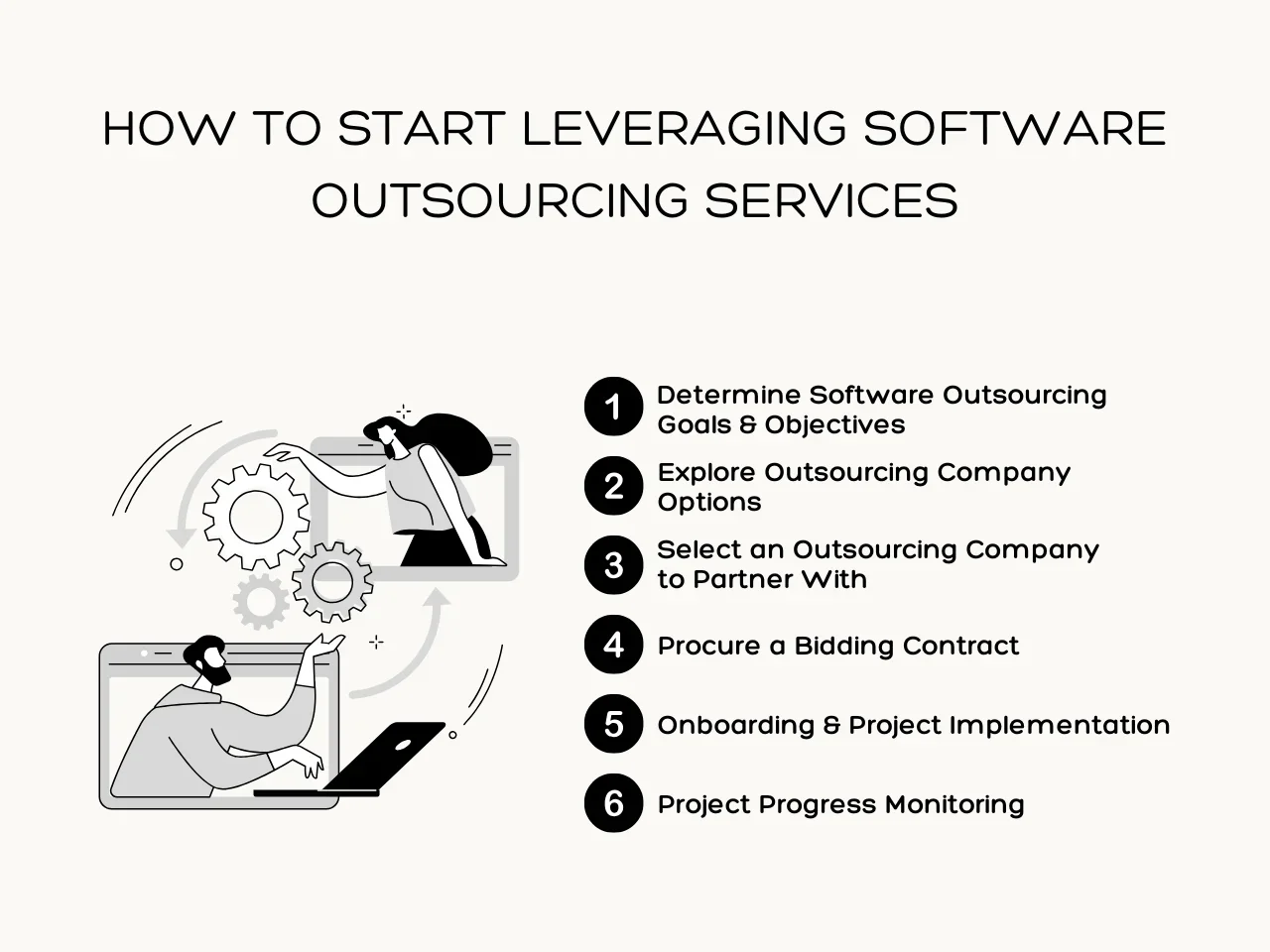
Step 1: Determine Software Outsourcing Goals and Objectives
The first step towards choosing the right software development companies to work with is to determine your goals and objectives. For example, you do guest posting and hire an outreacher who will be connecting with authors in your name. It will be more than enough if one of your marketers communicates with them and tracks their performance. But if you outsource a technology partner, you will have to arrange a whole team that can cooperate with them.
Listing out the goals you have ensures that the team you bring on aligns with business requirements and restraints, such as your timeline and budget. At this stage, it's also best to conduct project scoping.
Here are the key details to consider as you communicate the vision of your project in relation to outsourcing development:
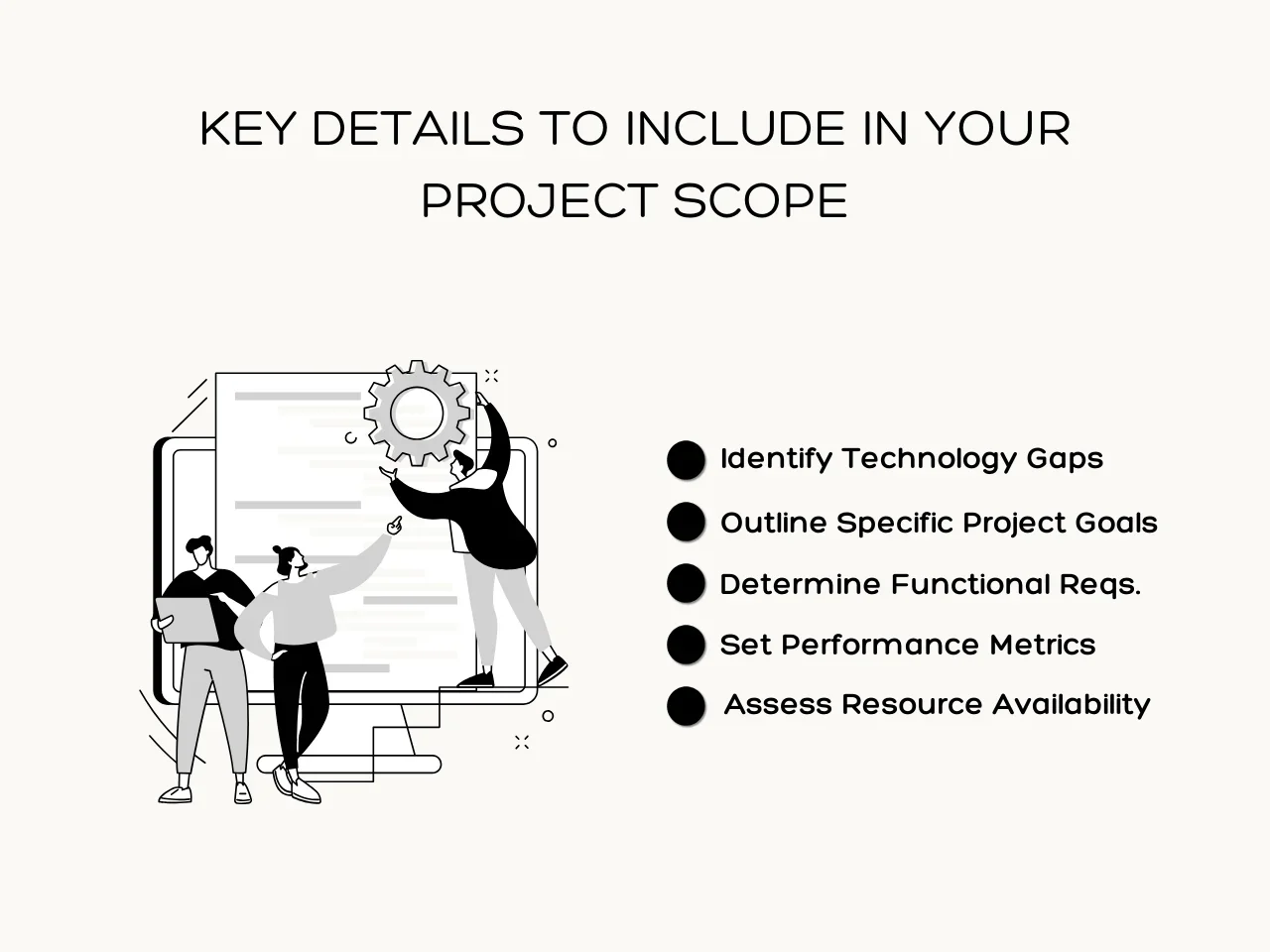
- Identify Technology Gaps: Pinpoint the technology gaps before you reach out to software product development companies. Doing so mitigates risks such as going over the provided timeline and budget. It also ensures that your project stays on track.
- Outline Specific Project Goals: Clearly define the short term and long term goals you aim to achieve with your project. This includes both the immediate deliverables and the long-term objectives. Having well-defined goals helps you select an outsourcing partner whose expertise and experience align with your project needs.
- Determine Functional Requirements: Identify the functional requirements of your software project. This involves specifying the features, functionalities, and user interactions that your software needs to include. Detailed functional requirements will guide the outsourcing team in delivering a product that meets your expectations.
- Set Performance Metrics: Establish performance metrics to measure the success of your project. These metrics include timelines, budget adherence, quality standards, and user satisfaction. Clear performance metrics help monitor progress and ensure that the outsourcing partner delivers according to the agreed standards.
- Assess Resource Availability: Evaluate the availability of internal resources, including personnel, technology, and budget. Understanding your resource constraints will help you determine the extent of outsourcing required and select a partner to complement your internal capabilities.
Step 2: Explore Outsourcing Company Options
After going through and outlining the details of your project scope, you'll have a better idea of what type of software outsourcing company and service and model to aim for. With that, you can start exploring software development outsourcing company options that align with your needs.
Remember that each service provider carries its own processes, services, and benefits, so it is always a good idea to conduct a thorough developer vetting process before finalizing anything. Keep in mind the type of outsourcing service you require, whether it be web development, mobile app development, or custom software development.
As you explore your options for software outsourcing services, here are the aspects to look into in a potential partner:
- Expertise and Experience: Look for case studies, portfolios, and client testimonials that demonstrate their ability to deliver successful projects similar to yours.
- Technical Skills: Ensure they are proficient in the programming languages, frameworks, and tools required for your project.
- Quality Assurance Processes: Ensure they have robust practices for identifying and fixing bugs, performing comprehensive testing, and delivering high-quality software.
- Flexibility and Scalability: Consider the company's ability to scale resources up or down based on your project needs.
- References and Reviews: Seek references and reviews from the company's previous clients. This can provide valuable insights into their reliability, professionalism, and ability to deliver on promises.
Carefully evaluating these aspects ensures you select a team that aligns with your needs and goals. It also provides a successful and productive partnership with the software outsourcing services you choose.
Step 3: Select an Outsourcing Company to Partner With
Once you've compiled a list of shortlisted candidates, it's time to start scheduling consultation and discovery calls with each one. Consultation and discovery calls give you a deeper insight into how their services best meet your needs.
During these calls, you can also request a proposal that outlines the following aspects of their provided service:
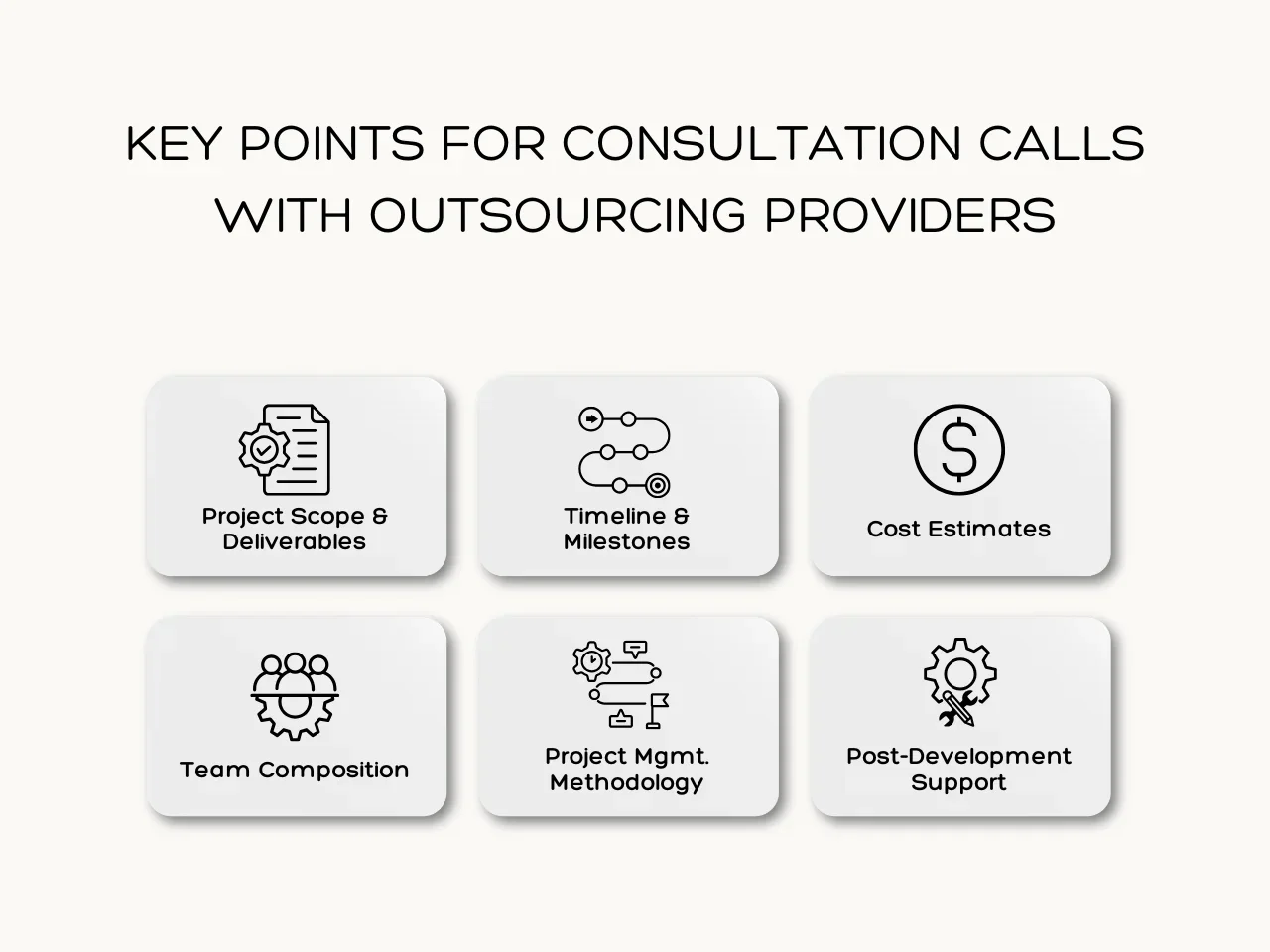
- Project Scope and Deliverables: Ensure the proposal clearly defines the scope and deliverables. This should include detailed descriptions of the functionalities, features, and milestones that the project will achieve.
- Timeline and Milestones: Review the proposed timeline and critical milestones. Ensure that the schedule aligns with your project's deadlines and that there are clear checkpoints for evaluating progress.
- Cost Estimates: This should include a detailed breakdown of costs associated with different phases of the project, resource allocation, and any additional expenses.
- Team Composition: Request information about the team members working on your project, including their roles, expertise, and relevant experience. Knowing the team composition helps ensure that the right skills are being applied to your project.
- Project Management Methodology: Understand the project management methodology that the outsourcing company will use. Whether it's Agile, Scrum, Waterfall, or another approach.
- Post-Development Support: Inquire about post-development support and maintenance services. The proposal should specify what support is available after completing the project, including bug fixes, updates, and ongoing maintenance.
Step 4: Procure a Bidding Contract
Before proceeding with the software development project, ensure that both parties sign a binding contract. This will reinforce the agreed-upon details and protect both parties. Outline the project duration, timeframe, budget, and other essential information.
Your bidding contract should also include all the specifics related to the project's scope, deliverables, payment terms, and milestones. This ensures that both parties clearly understand their responsibilities and expectations.
Additionally, the contract should address confidentiality agreements, intellectual property rights, and dispute resolution mechanisms to provide a comprehensive framework for the collaboration. Using agreement software can help streamline the process, making it easier to draft, sign, and store your contract securely.
Step 5: Onboarding and Project Implementation
Having finalized the bidding contract, you can start to onboard your outsourced developers into your business teams. Onboarding processes aim to integrate the external team effectively, ensuring a smooth transition and successful project implementation.
Here are some tips to follow when preparing an onboarding session with your new developers:
- Define Roles and Responsibilities: Clearly defined roles help prevent overlaps and misunderstandings and ensure that everyone knows their specific contributions to the project. You can use presentation tools like an interactive flipbook maker to outline these elements of a project.
- Set Up Communication Channel: Ensure all team members have the necessary accounts and know how to use these tools for real-time communication and updates.
- Establish Workflow and Processes: Clear workflows help maintain organization and ensure tasks are completed efficiently and accurately.
- Provide Training and Orientation: Offer training and orientation sessions to help the outsourced developers get acquainted with your company's tools, systems, and project requirements.
While managing a team of outsourced professionals may bring up certain challenges, employing free project management templates online aids in streamlined communication and task tracking, enhancing collaboration and outcomes.
Step 6: Project Progress Monitoring
As you implement the project, monitor progress to ensure everything stays on track. Regular monitoring helps identify issues early, which makes it easier to perform necessary adjustments and keep the project aligned with its goals and timelines.
Effective progress monitoring is essential as it defines the milestones and deadlines throughout the timeline. These milestones are checkpoints that assess progress and confirm that your project is moving as planned. Also, conducting regular reviews with your team helps them stay on track and address any delays or challenges as they arise.
Lastly, don't neglect to set up key performance indicators (KPIs) that measure the project's success and progress. KPIs can include task completion rates, adherence to deadlines, budget utilization, and quality of deliverables. Monitoring these indicators helps gauge the project's health and enables informed decision-making.
5 Common Scenarios When Outsourcing Is Needed
As you consider whether or not to outsource software development, it's good to evaluate the common scenarios that point to a need for outsourcing. To help you make a streamlined decision, here are the 5 common scenarios when outsourcing is needed:
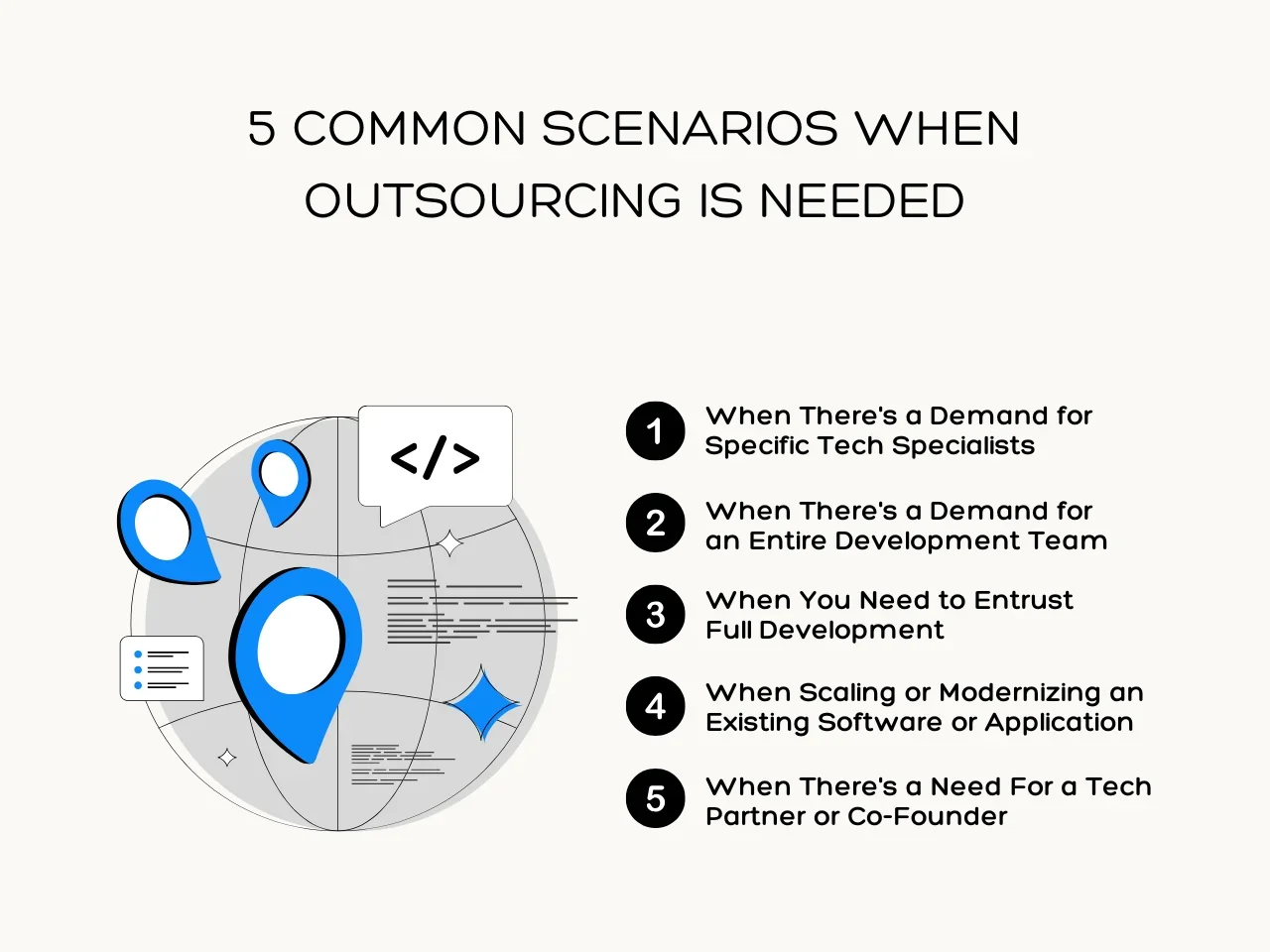
Scenario 1: When There's a Demand for Specific Tech Specialists
An in-house team of developers may need more expertise when creating a particular software project. In such cases, it may not be practical to hire a new employee to fill that gap should such skills only be required for one or two projects.
Based on your needs, you can partner with an outsourcing service provider to partner with a specialist in the fields within the software development process you need filled. This ultimately saves on the cost of hiring a new in-house employee while granting you the flexibility to scale your team based on immediate needs.
Scenario 2: When There's a Demand for an Entire Development Team
Building an entire in-house development team is costly and time-consuming for most businesses, especially for startups and small and medium-sized operations. This is where outsourcing services offer a viable solution. When you work with a software development service provider, you can access a complete team of professionals without requiring extensive hiring processes and overhead costs.
Scenario 3: When You Need to Entrust Full Development
Managing a software development project requires specialized expertise and experience that would not have otherwise been available to a business in-house. In such cases, entrusting the full development process to an outsourcing provider can be a strategic decision.
Scenario 4: When Scaling or Modernizing an Existing Software or Application
Running an online business often requires that it scale and modernize existing software applications and requires the team handling the project to be familiar with the latest technologies, best practices, and industry trends. Outsourcing this task can provide significant advantages, ensuring your software remains competitive and capable of meeting evolving business needs.
Scenario 5: When There's a Need For a Technology Partner or Co-Founder
In many startups and emerging businesses, there comes a point when the company's technical demands outgrow the existing team's capabilities. In such scenarios, companies may hire a chief technical officer or co-founder who can provide the necessary expertise, strategic direction, and leadership to drive technological growth and innovation.
Challenges of Outsourcing Development
Software outsourcing services provide businesses with a viable solution to their development needs in a highly fast-paced and ever-changing market environment. While it does come with a full list of potential benefits to leverage, there are also a few challenges that you may encounter if you do not adequately vet, manage, and monitor your partnership.
Let's go through the challenges of outsourcing development and how to overcome them so you can be prepared:
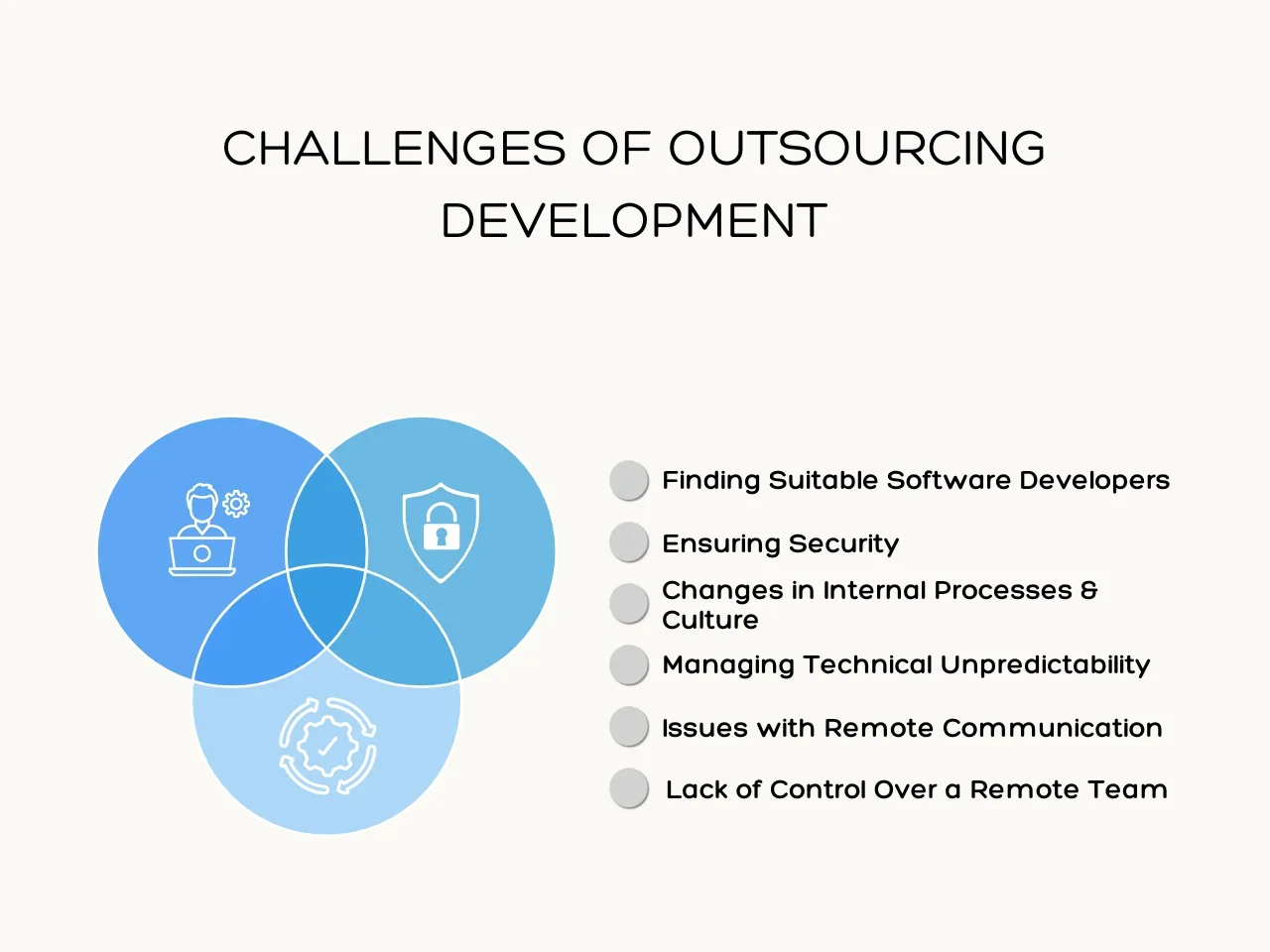
1. Finding Suitable Software Developers
Finding suitable software developers with the right skills and expertise can be challenging. The process involves thorough vetting to ensure that the outsourcing partner has a competent team that aligns with your project needs.
To ensure you work with the best software developers, conduct comprehensive research and interviews to assess a team's technical capabilities, experience, and cultural fit. A great option is to work with a software outsourcing service provider like Aloa, which can build, manage, and scale your team based on a project's scope.
2. Ensuring Security
Ensuring the security of sensitive data and intellectual property is a major concern when outsourcing development. Data breaches and unauthorized access can lead to significant financial and reputational damage.
The best way to prevent such risks from arising is to implement robust security measures, including a non-disclosure agreement (NDA). The NDA should specify secure data transfer protocols and compliance with industry standards and regulations. Additionally, conducting regular audits and monitoring the security practices of your outsourcing partner will help ensure everything stays within the bounds of the agreement.
3. Changes in Internal Processes and Culture
Working with an outsourced team may disrupt existing internal processes and affect company culture. Differences in work practices and communication styles can lead to misunderstanding and friction if not dealt with as soon as they arise.
A good way to prevent such conflicts is to establish transparent processes and communication protocols immediately. This fosters a culture of collaboration and inclusivity that involves the outsourced team in regular meetings and team-building activities. You can also provide training sessions to internal and external teams to align on best practices and company values.
4. Managing Technical Unpredictability
Technical unpredictability refers to unexpected bugs or performance issues during the development process. If not carefully mitigated as soon as possible, these challenges can delay project timelines and potentially increase costs.
While technical unpredictability is not always avoidable, implementing an agile development methodology allows for flexibility and rapid response to changes. Regular reviews and code tests help identify and resolve issues early on. Maintaining open communication channels to address any technical challenges that arise quickly is also beneficial.
5. Issues with Remote Communication
Remote communication is crucial for a successful outsourcing partnership. However, it can sometimes be hindered by time zone differences, language barriers, and a lack of face-to-face interactions. To overcome these challenges, make sure to use reliable communication tools and establish regular meeting schedules that accommodate different time zones.
Additionally, encourage teams to use video calls to foster personal connections and ensure clear communications. Altogether, these set expectations for response times and communication protocols that mitigate misunderstandings.
6. Lack of Control Over a Remote Team
Lack of control over a remote team can lead to project management and accountability issues. Ensuring that your remote team follows the project timeline and quality standards becomes a challenge as a breakdown in expectations and communication occurs.
To prevent a lack of control from escalating to severe levels, it is essential to define the project milestones, deliverables, and performance metrics right from the start. You can use project management tools to track processes and maintain visibility over the project. It's also best to schedule regular check-ins and status updates to monitor performance and address deviations as soon as possible.
7 Outsourcing Strategies To Achieve Better Outcomes For Finding And Working With The Right Developers
Understanding the types of software outsourcing services and models, along with how to leverage such services, is a great way to get started on the right track. To further ensure that you experience a seamless project implementation process, here are 7 outsourcing strategies that lead to better outcomes when finding the right developer to work with:
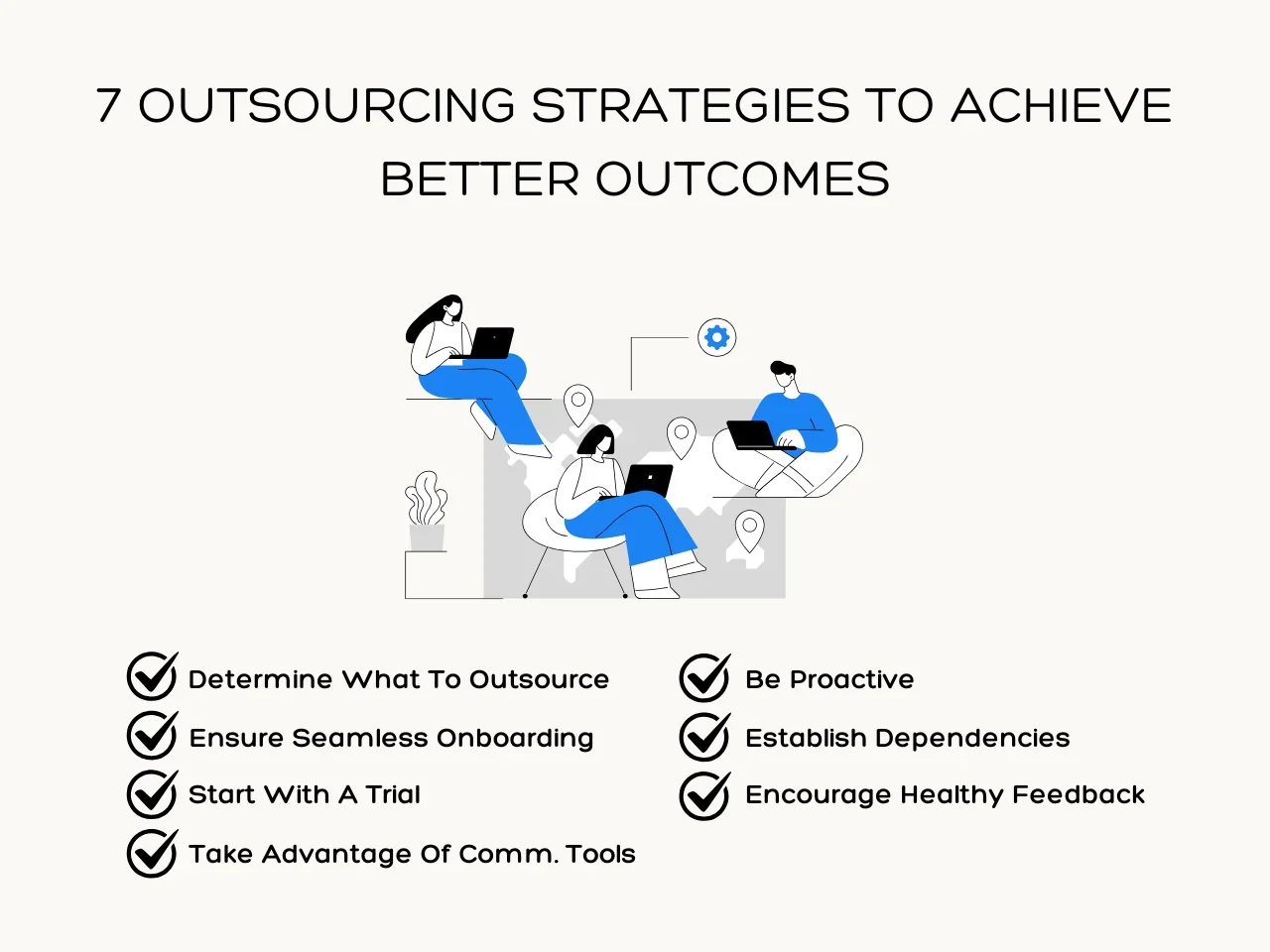
1. Determine What To Outsource
Not all aspects of a project may need to be handed over to an external team. It's best to list the expertise you lack in-house and identify the specific components of the project that would benefit most from outsourcing. This focused approach ensures you leverage external skills where they are most needed while retaining control over core areas.
2. Ensure Seamless Onboarding
Providing your outsourced team with a seamless onboarding process is crucial for integrating them into your operations. Providing them with access to all the necessary tools and resources contributes to a productive workflow with clear communication. Overall, this will provide a comprehensive foundation that helps new team members get up to speed quickly so they can start implementation productively.
3. Start With A Trial
Before fully committing to an outsourcing partnership, consider starting with a small trial project. Starting in this manner allows you to evaluate the outsourcing provider's performance, communication, and compatibility with your internal teams. Additionally, a trial project helps you assess the team's ability to deliver quality work within a specified timeframe and budget. Based on the outcome, you can decide to continue the partnership and potentially scale the project.
4. Take Advantage Of Communication Tools
Communication tools are essential when working with remote developers. Set up video, chat, and collaboration communication tools to ensure you can communicate instructions across various teams. These tools also help develop rapport among team members from the in-house and outsourced sides. In the long run, these two teams will be able to work together seamlessly on the project's deliverables and maintenance.
5. Be Proactive
Proactively managing your outsourced team is key to avoiding potential issues and ensuring project success. Regularly check in with the external developers to monitor progress, address concerns, and provide feedback. Anticipate potential challenges and address them early to prevent escalation. Proactive management also involves adjusting project scopes, timelines, or resources as needed to stay aligned with your objectives.
6. Establish Dependencies
Dependencies are the relationships between tasks or components of a project. This is when one task relies on the completion of another before it can start. Taking the time to clearly define these dependencies makes for effective project management. Additionally, mapping out dependencies helps the team set realistic timelines, coordinate tasks efficiently, and avoid bottlenecks. Communicating these dependencies to the internal and outsourced teams ensures alignment and a smooth project progression.
7. Encourage Healthy Feedback
Encouraging healthy feedback mechanisms fosters an environment where ideas and collaborative approaches are valued. This leads to continuous improvements and project success while creating transparent communication channels between internal and outsourced teams. Healthy feedback helps teams identify areas for improvement, which enhances overall collaborative efforts and streamlines the effectiveness of your outsourcing efforts.
7 Best Software Outsourcing Companies of 2024
To help you begin your search, Here are the 7 best companies with established a reputation for providing top-notch software outsourcing services and have a strong track record of delivering successful projects for their clients.
1. Aloa - Top Pick for Software Outsourcing Services
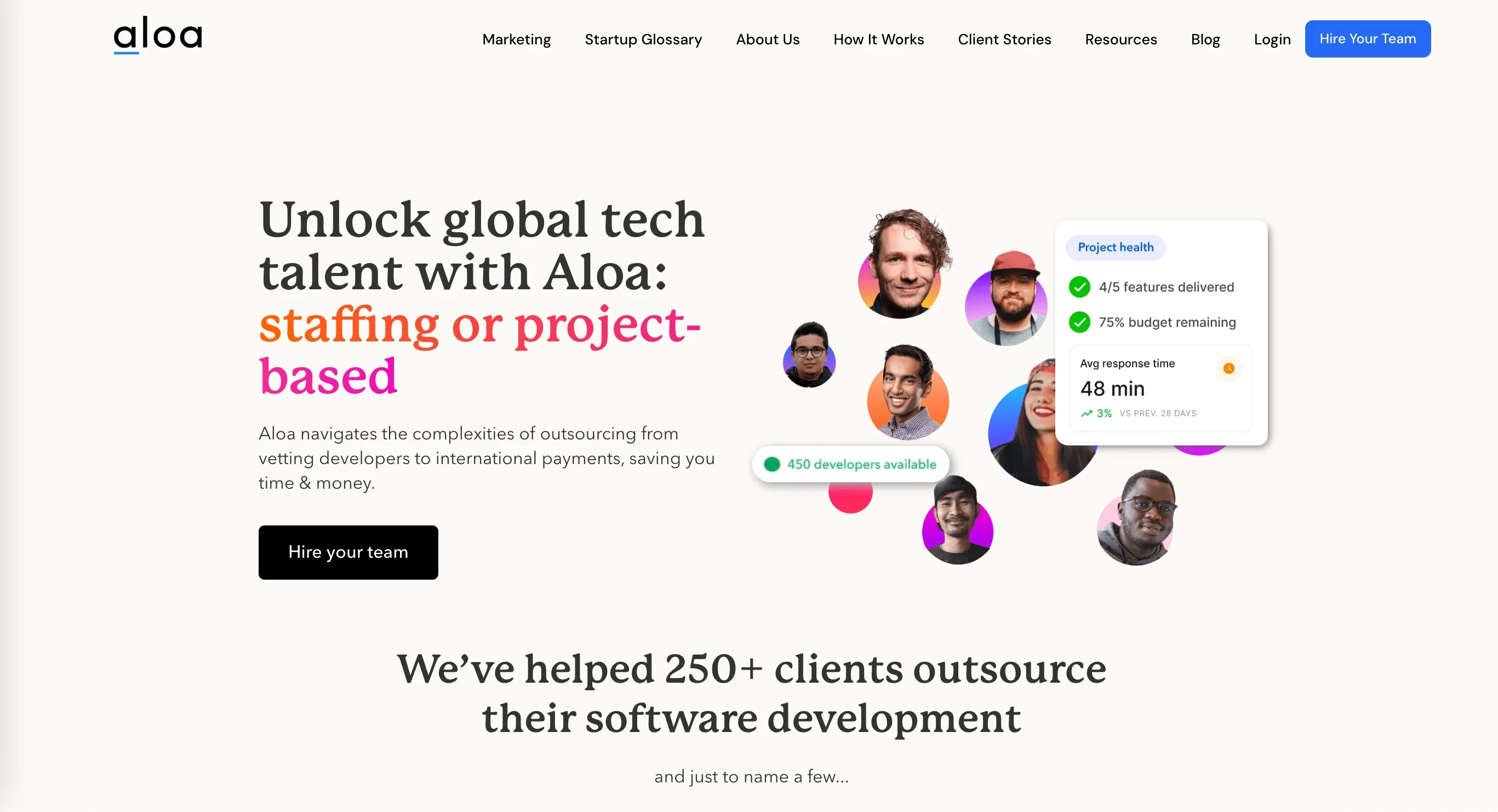
Aloa is a global leader in helping businesses scale their software development teams. Whether you are looking to staff multiple software developers or build out custom software solutions, Aloa ensures that you are working with the best software development talent from around the world.
Aloa has vetted 10,000+ software agencies around the globe to identify and hire the best outsourced software development professionals with expertise in multiple industries. Our strict vetting process sets you up for success, giving you a clear path to interviewing top-tier candidates.
The developers in our network are fully equipped to handle any sort of software development project such as front end, back end, and mobile development. Additionally, their expertise extends to emerging technologies like AR, VR, IoT, and Web 3 to ensure you get the best custom software solutions that enables your business to scale and grow with the market.
Aloa will deliver Performance Reports to ensure you receive consistent updates on your project's progress so you stay informed and confident with every step. At Aloa, we make sure that you get your software [BUILT/DESIGNED] on time, on budget, and high quality.
2. Mphasis - Ideal For Financial Services
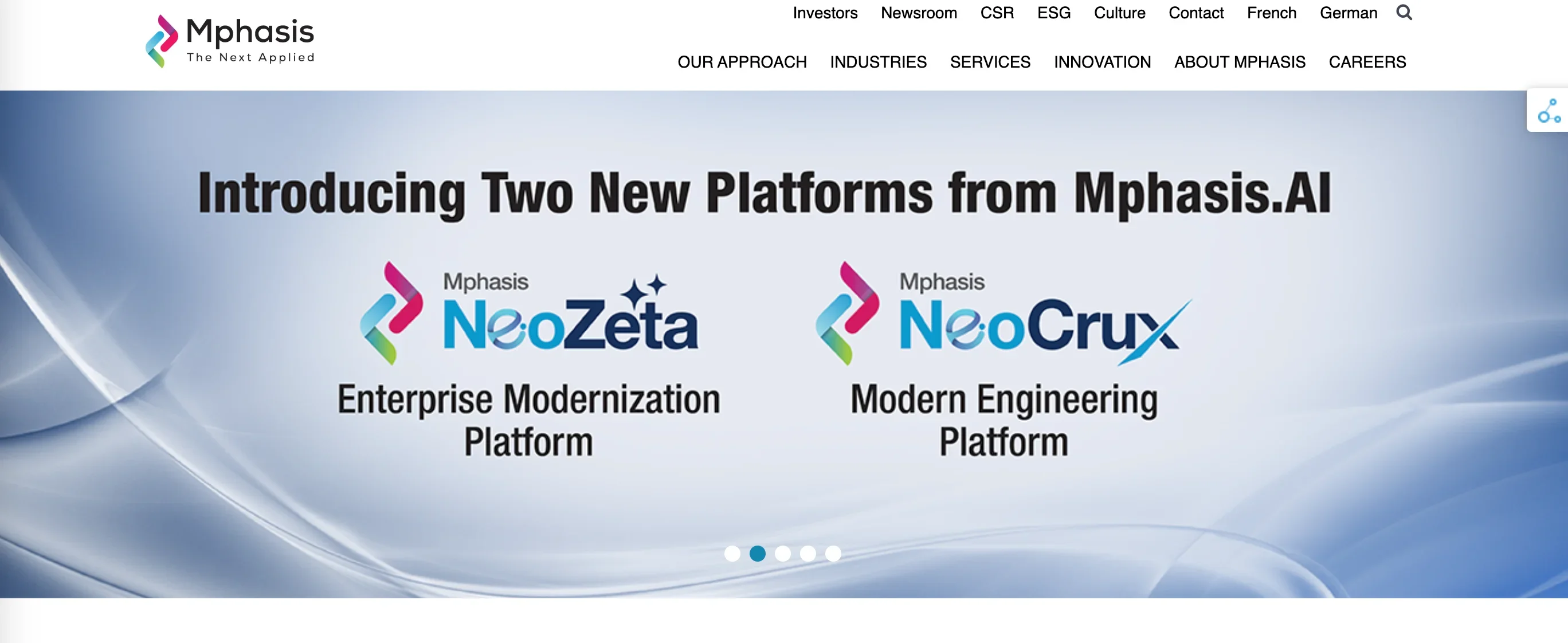
Mphasis has been providing top-notch software outsourcing services since 2008. For over two decades, they have worked with clients worldwide to create custom solutions for their financial service needs. With a global footprint and deep domain expertise, Mphasis is a trusted name in the industry.
Mphasis transforms enterprises through its proprietary FRONT2BACK framework which prioritizes a customer-first perspective. This framework harnesses the capabilities of cloud and cognitive technologies to deliver highly personalized digital experiences to clients and their end-users.
3. Binmile - Leveraging Next-Gen Technologies

Binmile is a software outsourcing company that is taking the industry by storm with its impressive approach to software development. It's an ISO 9001:2008 & 27001:2013 certified company, ensuring that quality and security are at the forefront of its operations.
One of the key reasons why Binmile is a great option for software outsourcing is its Global Delivery Model. With offices located in India, the USA, the UK, and Indonesia, Binmile offers its clients the best of both worlds with its unique Global Delivery Model - local presence and cost-effectiveness.
This allows its clients to take advantage of the technical expertise and lower costs offered by its offshore team, while still maintaining close relationships with its onshore team.
4. Flatworld Solutions - A Trusted Name In Software Outsourcing

Flatworld Solutions, established in 2002, is a one-stop shop for all your outsourcing needs. With its ISO certification, you can be assured that the company operates with the highest standards of quality and professionalism.
The company has a widespread presence with over 10 delivery centers located in countries such as India, the UK, the USA, Colombia, and many others. The 5-stage outsourcing process of Flatworld Solutions is another factor that sets it apart from its competitors. The process is designed to ensure seamless and efficient delivery of projects, right from the requirement gathering stage to post-deployment support.
They have a dedicated Project Management, Transitions, and Customer Engagement team that is available 24 hours a day. The team works closely with clients to understand their requirements and ensures that the projects are delivered on time and within budget.
5. Qubit Labs - Innovative Solutions, Personal Touch

Qubit Labs is an ideal software outsourcing partner because of its strong track record of delivering quality results. They understand that the success of your project depends on the people working on it so they adopt a very personal approach to hiring and take the time to carefully screen and select each and every team member.
Qubit Labs also has a wide range of expertise to draw from. Whether you're looking for help with game development, eCommerce, automotive, or healthcare, they've got you covered. They believe in being upfront about pricing so you know exactly what you're paying for and what you can expect in return. No hidden fees, no surprises.
6. SumatoSoft - Partnering For Progress

SumatoSoft has over a decade of experience in the industry and has established a reputation for delivering high-quality software solutions that meet the needs of its clients. One of the reasons that make SumatoSoft a great choice for outsourcing is its impressive customer satisfaction rate of 98%. This is a testament to the company's commitment to providing top-notch services that exceed their clients' expectations.
SumatoSoft makes use of project management systems like Jira and Confluence to keep their clients informed of the development progress at all times. With these tools, clients can track the progress of their projects, review the status updates, and provide feedback as needed. They have a team of dedicated project managers who work closely with their clients to ensure that their needs and expectations are met.
Choosing the right tools and platforms is crucial when working with SumatoSoft for software outsourcing, from generating a freelance invoice template that ensures transparent payment terms to managing project milestones and development costs. SumatoSoft provides customized software solutions, and leveraging the right invoicing and collaboration tools can enhance project efficiency and financial clarity. By selecting the best resources, businesses can streamline payments, optimize workflows, and maintain strong partnerships with their outsourced development teams.
7. Belitsoft - Elevate Your Technology

Belitsoft is a well-known software outsourcing company that provides top-notch software development services to businesses of all sizes. One of the key features that sets Belitsoft apart from its competitors is its ease of working with. Belitsoft’s team is highly responsive and always available to answer any questions or concerns, ensuring a smooth and seamless experience for clients.
One of the most critical factors in outsourcing software development is the stability and reliability of the development team. Belitsoft has an impressively low employee attrition rate of 12% p.a., ensuring that their clients' projects are not impacted by frequent personnel changes. They have a customer retention rate of 90% which speaks volumes about their quality of work and customer satisfaction.
Key Takeaway
Software outsourcing services have become a core business solution for companies looking to work with the best tech talent globally to create custom software solutions. As the need for digital transformation continues to grow to attain a global presence in the market, these services will continue to escalate in importance.
Companies that leverage outsourced development services benefit from access to a diverse pool of skilled professionals, cost savings, and the ability to focus on core business activities. Additionally, outsourcing allows businesses to scale their operations quickly, adapt to market changes, and accelerate time-to-market for their products.
Aloa offers comprehensive software outsourcing services for various software development needs. Email us at [email protected] to schedule a consultation call with our Account Executives. We'll discuss your project scope and connect you with the ideal professionals to address your business goals.

